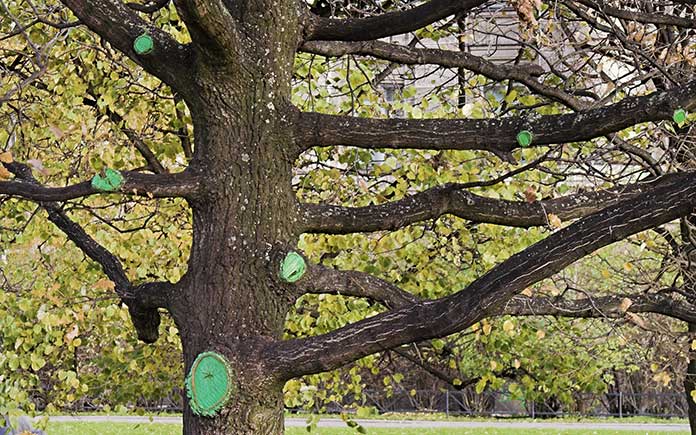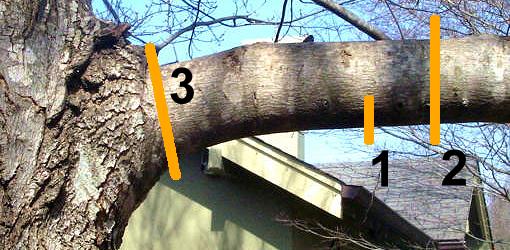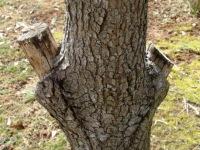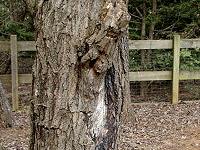Cherry Blossom Tree Branch Drawing

If you're trimming heavy tree limbs, you have to be extra careful not to damage the bark or interfere with the tree's natural healing response.
Doing it right is actually no more difficult than doing it wrong, particularly if you think ahead to how much work it would take to remove a dead tree!
Here's how to cut large tree limbs in your yard in three simple steps.

How Trees Heal
The truth is, trees don't actually heal as we do. When you cut off a tree branch, the tree forms a special callous tissue (like a scar) that covers over the wound to keep out disease and decay.
That scarred part of the tree will be there forever, sealed off so that the rest of the tree can keep growing. It's very important to prune trees correctly so that we don't interfere with this process – incorrect pruning will leave the tree weak and vulnerable to disease.
In the top photo, you can see the evidence of several large pruning cuts. The bumps show well-healed pruning scars, most of them completely covered over.
The "donut" shaped scar is normal, too. The callous tissue grows from the outside edges toward the center, so it's still in the process of sealing over.

How to Cut a Tree Limb
Proper pruning of large tree limbs involves three cuts:
- Cut #1, Notch Cut: Cut a small notch in the bottom of the limb, 2-3 feet away from the trunk, and about a quarter of the way through. This notch will keep the bark from splitting when you make the next cut.
- Cut #2, Relief Cut: Just outside the notch, make a relief cut completely through the branch. This removes the weight of the branch so that you can make your final cut without the branch splitting and falling.
- Cut #3, Final Cut: This is the one that matters! Your final cut should be right where the branch collar (that swollen bump) transitions to smooth branch bark. Follow the slant of the branch collar. If you can't fit your saw into the crotch at the right angle, then cut it from the bottom up.
Common Tree Trimming Mistakes
 Cutting the Branch Too Short: We used to think that branches should be cut off flush with the trunk – boy, were we ever wrong! The branch collar is responsible for forming the scar tissue. If you cut into the branch collar, the tree will have a very hard time recovering. When you see rotten holes in tree trunks or seeping wounds, you're looking at the aftermath of cutting off the branch collar.
Cutting the Branch Too Short: We used to think that branches should be cut off flush with the trunk – boy, were we ever wrong! The branch collar is responsible for forming the scar tissue. If you cut into the branch collar, the tree will have a very hard time recovering. When you see rotten holes in tree trunks or seeping wounds, you're looking at the aftermath of cutting off the branch collar.
 Leaving the Branch Too Long: The branch collar on the trunk can only do its job of allowing the wound to heal if all of the branches that it has to cover over have been removed while leaving the branch collar itself intact. In the photo on the right, you can see how the branch stubs that were left too long are interfering with and actually preventing the healing process from taking place.
Leaving the Branch Too Long: The branch collar on the trunk can only do its job of allowing the wound to heal if all of the branches that it has to cover over have been removed while leaving the branch collar itself intact. In the photo on the right, you can see how the branch stubs that were left too long are interfering with and actually preventing the healing process from taking place.
 Failure to Make the Relief Cuts: If you fail to make the relief cuts and remove most of the weight of the limb before trimming the branch back to the trunk, you run the risk of having the branch split off. This can cause substantial damage to the trunk, as seen in the photo at right. This can make the wound on the trunk susceptible to disease and insect infestation and take much longer to heal.
Failure to Make the Relief Cuts: If you fail to make the relief cuts and remove most of the weight of the limb before trimming the branch back to the trunk, you run the risk of having the branch split off. This can cause substantial damage to the trunk, as seen in the photo at right. This can make the wound on the trunk susceptible to disease and insect infestation and take much longer to heal.
Further Information
- Trimming Limbs (video)
- Treating Cut Tree Limbs With Wound Paint (article)
- When To Trim Trees and Shrubs (article)
- Basic Shrub Pruning Techniques (article)
Cherry Blossom Tree Branch Drawing
Source: https://todayshomeowner.com/how-to-trim-large-tree-branches/
Posted by: lomaxpoccour.blogspot.com

0 Response to "Cherry Blossom Tree Branch Drawing"
Post a Comment